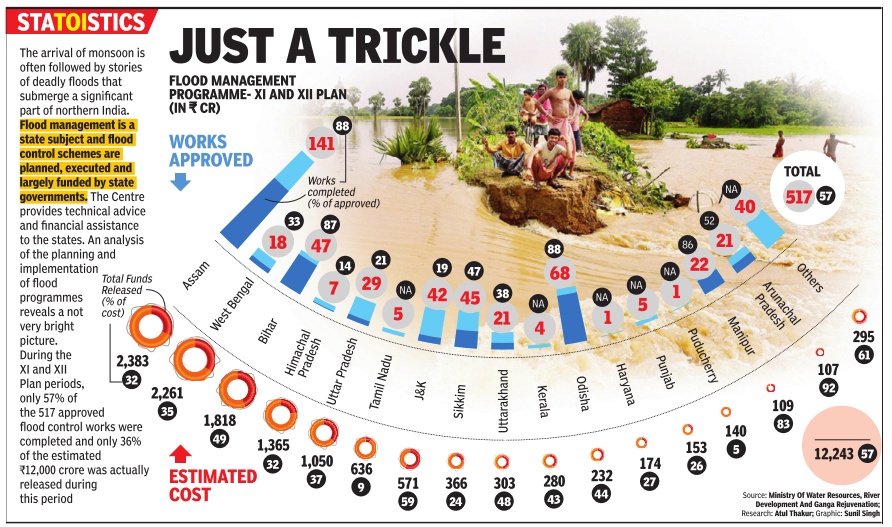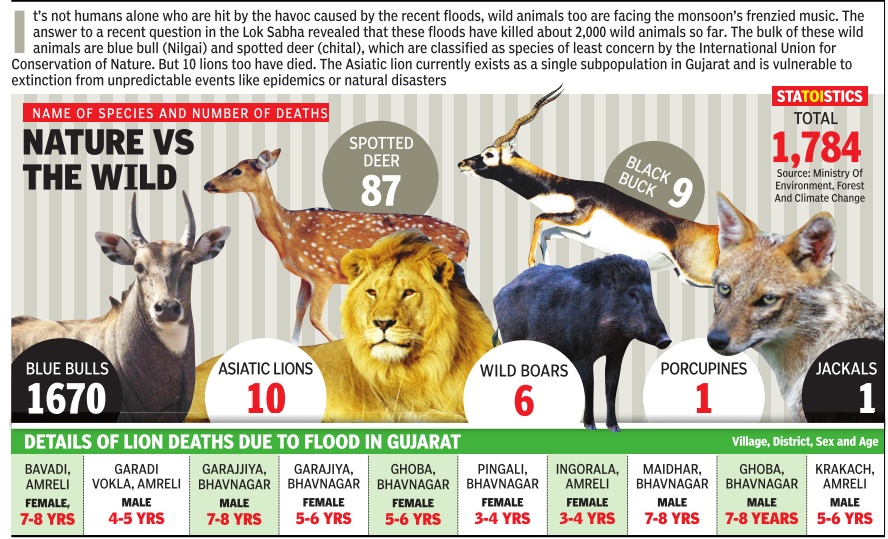Floods in India

This is a collection of newspaper articles selected for the excellence of their content. |
Contents |
The damage caused by floods
Floods affect 3cr Indians every year
Atul Thakur TIMES INSIGHT GROUP 2013/06/20
New Delhi: Chronic floods during the monsoon on an average affect more than 30 million Indians annually. Ironically, 60% of India’s farmland, 66% of its livestock and its entire forest area depend on rains for survival.
Loss to agriculture and livestock
According to a recently released Central Water Commission (CWC) report, on an average 7.21 million hectares (roughly 72,000 sq km) go under floodwater. This water typically ravages 3.78 million hectares of agricultural land, damaging crops worth Rs 1,118 crore annually. Heavy rains and floods account for nearly 1,700 lives lost annually. Apart from this, 1.25 lakh houses are annually damaged by torrential rains that also wipe out nearly 96,000 livestock.
Floods are the most recurrent natural calamity, hitting India almost every year. According to the CWC’s report on “financial aspects of flood control, anti-sea erosion and drainage projects”, it is not possible to provide absolute protection instantly to all flood-prone areas. It says that such an attempt will neither be practical nor economically viable.
Marginal decline in flood-affected areas since 1953
The CWC’s analysis of floods in India from 1953 to 2011 shows a marginal decline in flood-affected areas over the years. The data shows 1977, 1978 and 1979 were the worst-hit. The 1977 floods killed over 11,000 people — six times the average for the 59 years between 1953 and 2011. In terms of area and population affected, the floods of 1978 were most destructive.
Financial loss
In terms of financial loss, recent floods have been far more destructive. The total loss of crops, houses and public utilities in 2009 was Rs 32,541 crore, the highest for any year. The 2003 floods destroyed crops worth Rs 7,298 crore, while the flood-induced damage to houses was more than Rs 10,000 crore in 2009, the maximum so far.
The report shows there was a continuous increase in the population affected till the mid-eighties; thereafter, the number has slowly declined
Animals killed in Indian floods

2015
November-December floods in South India: Economic loss
Oneindia, December 10, 2015
Oneindia
Floods cause $3 bn loss in India in Nov-Dec, says Aon Benfield
Torrential rains, which caused floods in South India in November and early-December, has led to economic losses to the tune of USD 3 billion (about Rs 20,000 crore), a report said today. According to reinsurance broker Aon Benfield's monthly Global Catastrophe Recap report, economic developments in Asia are taking place in flood plains and marsh lands with scant attention to drainage, thus increasing run-off and flooding. An enhanced North East monsoon impacted by the current El Nino brought weeks of torrential rainfall to southern India and Sri Lanka for much of November into early December, the report said. Portions of Tamil Nadu and Andhra Pradesh in India and Sri Lanka were heavily impacted by floods. There were severe impact to agricultural interests and infrastructure as rivers swelled into both rural and urban areas. Chennai metropolitan region was particularly damaged by the event, it added. "Total economic losses in India were estimated to reach as high as Rs 200 billion (USD 3 billion). India's General Insurance Corporation claims possibly reaching up to Rs 20 billion (USD 300 million)," it revealed. Aon Benfield's report evaluates the impact of the natural disaster events that occurred worldwide. The firm's Head of Impact Forecasting Asia Pacific Adityam Krovvidi says that scant attention to drainage while pursuing economic developments in Asia is also a major cause of flooding. "The 100-year rainfall event in Chennai exposed the inherent weakness of the one-dimensional nature of this economic pursuit and highlights the need for serious introspection, implementation of mitigation measures and the redesign of urban landscapes," he added. Risk assessment can play a major role in awareness and insurance in mitigating the financial hardships. The large gap between the economic and insured loss from the Chennai flood event further emphasises the need for greater insurance penetration in large industrialized cities in Asia, he said. "This will become even more important as Asian megacities continue to grow and the risk of major urban flood events increases," Krovvidi said.
